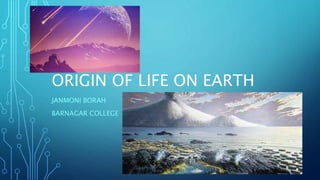
Origin of life on earth
- 1. ORIGIN OF LIFE ON EARTH JANMONI BORAH BARNAGAR COLLEGE
- 2. DEFINITION OF LIFE • There is not a single, perfect definition of life, because life is a process, it is not a substance. • One popular definition is that organisms are open systems that maintain homeostasis, are composed of cells, have a life cycle, undergo metabolism, can grow, adapt to their environment, respond to stimuli, reproduce and evolve. • According to NASA, life is “a self-sustaining chemical system capable of Darwinian evolution:. • More simply, life is “matter that can reproduce itself and evolve”
- 4. DIFFERENT TYPES OF LIFE
- 5. TYPES OF CELL : PROKARYOTIC AND EUKARYOTIC
- 6. BIOMOLECULES • Biomolecules are special molecules of Carbon. • Carbohydrates, lipids, proteins and nucleic acids are the main classes of biomolecules. • Carbohydrates provide energy, lipids are the main structural components of cell membranes, proteins are the building blocks and catalyst. • DNA and RNA are the peculiar class of biomolecule that can reproduce and replicate themselves. They also act as the genetic and hereditary material.
- 8. ORIGIN OF LIFE • Almost every religion believe God created the earth and all the organisms. • Charles Darwin was the first person to challenge the God as the creator and he postulated that all the organisms on the earth evolved through natural selection from a single common ancestor who existed long long ago. • Some people believe the seed of life on earth came from other parts of the universe along with meteorites and this theory is called the ‘panspermia’ theory. • Till today, our Earth alone is known to host life. There may be billions of earth like places in the universe with more advanced civilizations, or may not be. Titan and Europa, two moons of Saturn are strongly believed to be home of living forms in our solar system.
- 9. THE PREBIOTIC EARTH • Our solar system originated about 4.567 billion years ago. • During the first billion years, earth was inhospitable to life. It was very hot, there was no water, soil, oxygen. • The oldest fossil till discovered dated 3.8 billion years ago. • It is now impossible to recreate the original environment of earth in laboratory. It is unknown where and when exactly the first life originated on earth.
- 10. THE ABIOGENESIS THEORY • Oparin and Haldane(1929) postulated that life originated in the primitive environment of earth from simple inorganic substances. • Different lighter atoms like Hydrogen, oxygen, nitrogen, carbon etc. combined to each other to form inorganic compounds like NH3, H2O, H2S etc. The energy required for such chemical reaction was obtained from sunlight, volcanic activity, thunderstorm etc. • These simple inorganic molecules further reacted with each other to form some simple organic molecules like amino acids, sugars, nucleotides etc. • Small organic molecules polymerized to form large biomolecules like carbohydrates, lipids, protein, nucleic acids etc. These molecules later organized themselves to form the first cell-like structure which can reproduce and evolve.
- 11. UREY AND MILLER’S EXPERIMENT • Experimental proof to the abiogenesis theory was provided by Urey and Miller(1951) • They tried to recreate the primitive environment of earth in laboratory. CH4, NH3, H2 and H20 was kept in a specially designed chamber for almost a week, provided with heat and electric shock. • They analysed the water after the completion of the experiment and confirmed the presence of simple amino acids, sugars etc. • This experiment proved that the biomolecules necessary for life process were created from simple inorganic molecules in primitive environment of earth.
- 13. • Almost all scientists now a days believe this theory of inorganic origin of life. • Darwin postulated hot primitive ponds to be origin of life. • Some scientist believe under surface uranium-rich pockets served as the home for primordial life. • Underwater volcanos, hot springs etc are also believed to be the first place where life first originated.
- 14. • Darwin’s warm little pond
- 16. LUCA (LAST UNIVERSAL COMMON ANCESTOR) • With the help of tools of molecular biology, the probable ancestor of all life forms on present day earth has been traced, and found to be an organism who lived almost 3.8 billion years ago. But no fossil evidence found till date. • It shares almost 350 genes with all life forms. • It was an unicellular prokaryotic microbe. • It was chemotrophic. • It had RNA as genetic material.
- 17. LUCA
- 18. EVOLUTION • Evolution is the process by which one life form gradually changes to a different one. It is a very slow but continuous process. • All the living organisms on earth are the result of evolution. All organism, including human, continue to evolve. • Evolution started from the point of formation of first organic material on earth. Hence, organic evolution. • Forces behind evolution include mutation, chromosomal abberrations, natural selection, bottleneck effect, genetic drift etc.
- 19. • Origin of life
- 20. THANK YOU